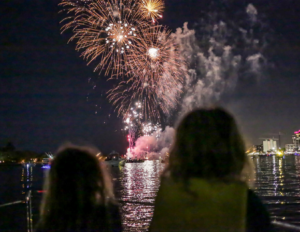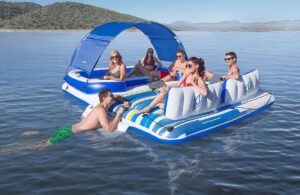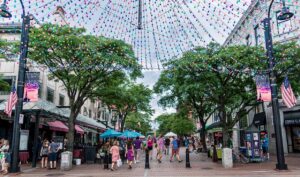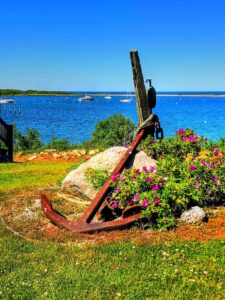Ever dream of moving to a seaside town where boating is a way of life? Look no further than these five charming home ports.
Oriental, North Carolina
This quiet, New England-y coastal village is known as the Sailing Capital of North Carolina for good reason — there are more than twice as many registered boats as permanent residents here, and at one time its town fathers were “pretty sure” it boasted more circumnavigators per capita than anyplace else in the world.
Oriental sits along the Intracoastal Waterway at the convergence of five navigable creeks and the beautiful Neuse River, not far from Pamlico Sound, which stretches 30 nautical miles to the famed Outer Banks and the Atlantic Ocean beyond. As a result, you can cruise, fish, paddle and play to your heart’s content.
But this is also a great place to simply kick back and relax. The “downtown” area is home to several marinas and commercial fishing outfits, plus a number of pubs and restaurants, where you can watch the boats come and go. Oriental has also developed into a thriving arts colony with a plentiful palette of galleries and boutiques and a warm, welcoming atmosphere.
River Dunes (252-249-4908, riverdunes.com), a community just north of Oriental, offers new homes and a worldclass resort harbor with every convenience for year-round living and boating. Its marina features 400 slips, state-of-the- art floating docks, a 500-foot fuel dock with high-speed diesel, a pool, a fitness center, dining and more.
Beaufort and Port Royal, South Carolina
For what seems like eons, a racy afternoon in the Low Country has consisted of hanging a line off the end of a dock and seeing what happens. Not much has changed, and while golf has joined the roster as a popular pastime, the communities of Beaufort and Port Royal remain as grounded as they were hundreds of years ago.
Southern hospitality flourishes here — Coastal Living magazine named Beaufort America’s Happiest Seaside Town — as does a culture steeped in myriad customs and proclivities. You can’t walk (or bike) too far without running into an old mansion or monument or a new art gallery or curio store. Surrounding it all are vibrant marshes nestled beneath the moss-draped limbs of massive live oaks.
Life in Beaufort and Port Royal is defined by water with a respectable fishing fleet serving the many homegrown restaurants. Kayaking, sailing, angling and beachcombing are ample, as are festivals dedicated to the Low Country and its wonderful diversity.
On the ICW, the Downtown Marina of Beaufort (843-524-4422, downtownmarinabeaufort.com) lies within
walking distance of numerous eateries, bed and breakfasts, historic homes and parks. Port Royal Landing Marina (843-525-6664, portroyallandingmarina.com) also on the ICW to the south, can be accessed from the ocean through both Port Royal and St. Helena sound. It features an on-site restaurant, boaters’ lounge, and multiple patios for basking in the cool breezes.
Golden Isles, Georgia
Just off the Atlantic Coast, midway between Savannah, Ga., and Jacksonville, Fla., lie the Golden Isles, so named for their radiant beauty and gleaming stretches of sand. Native Americans, European explorers, pirates and tycoons have all left their footprints here, creating a setting rich in history and luxury.
St. Simons Island, the largest of the grosup, is dotted with modern villages boasting seaside shops and restaurants, as well as attractions such as the Neptune Park and Fun Zone, the St. Simons Lighthouse Museum and the Maritime Center. Little St. Simons is accessible only by boat, a natural oasis for outdoor pursuits. Sea Island is dominated by the renowned Cloister on Sea Island resort and its world-class golf courses, while Jekyll Island is home to the majestic Jekyll Island Club Hotel, once the exclusive retreat of J.P. Morgan, William Rockefeller, Vincent Astor and William K. Vanderbilt.
The Golden Isles are truly a multifaceted treasure, and the thriving city of Brunswick, hugging the adjacent shoreline of Georgia, provides the ideal spot from which to launch your island-hopping adventures. Morningstar Marinas (912-634-1128, morningstarmarinas.com) operates high-quality properties through out the mid-Atlantic and southeastern U.S., including one on St. Simons Island. Just a mile north of the ICW, it has 137 slips and amenities such as a swimming pool, a picnic deck with grill, a restaurant and a dive shop.
Punta Gorda, Florida
People don’t come to Punta Gorda for the beaches, because there aren’t any. They come for the Old Florida ambiance — the brick lanes lined with palm trees, the tin-roof homes, the quaint fishing shacks and the vibrant murals painted on the buildings downtown.
Local preservationists have tried hard to keep the nostalgic feel alive, and it’s worked, but that doesn’t mean the city is trapped in slow motion. Rather, it’s a haven for outdoor enthusiasts, with a scenic pedestrian promenade (Harborwalk), the state’s second largest harbor (Charlotte Harbor) and a collection of nearby islands for boating escapades (the Gulf Islands).
Happily, Punta Gorda’s newer developments are doing their part not to upset the dock cart. Fishermen’s Village, a tourist attraction that features specialty shops and seven restaurants, is built in the style of a salty seaside port. It also houses furnished luxury villas, and its marina has 111 slips and free daytime docking for visiting vessels.
Burnt Store Village is a 600-acre gated community located minutes from its namesake marina, which has on-site resort and golfing facilities. Burnt Store Marina (941-637-0083, tburntstoremarina.com) is located on Charlotte Harbor, named one of Sail magazine’s Top 10 Places to Sail.
With all this to offer, it’s no wonder Punta Gorda was also named one of the Top 10 Places to Retire Healthy by U.S. News & World Report.
Apalachicola, Florida
Once the third largest port on the Gulf of Mexico, Apalachicola resonates with the sights and sounds of a bygone era. The steamboats and schooners may have disappeared, but the town retains a working waterfront, bustling with weatherworn shrimp and oyster boats, now buttressed with an array of fine restaurants, museums and boutiques.
Today, the maritime town features an eclectic mix of old and new, with more than 900 turn-of-the-century homes and buildings alongside luxury waterfront accommodations. One thing that hasn’t changed is the area’s bountiful natural resources. The Apalachicola River and Apalachicola Bay provide great fishing opportunities for both freshwater and saltwater species. Lovers of the outdoors can explore the endless bays and waterways by kayak, canoe, sailboat and powerboat.
Scipio Creek Marina (850-653-8030, scipiocreekmarina.com) is Florida’s largest marina facility and is located within walking distance of the historic district’s shops and attractions. Family-owned, it offers a friendly atmosphere and prides itself on providing visitors with whatever they need to enjoy their stay.
Water Street Hotel & Marina (850-653-3700, waterstreethotel.com) is a new destination in Apalachicola
with 30 suites designed in an Old Florida spirit. Conveniences include a 20-slip marina, a pool, meeting facilities and screened porches on the water. It’s located four blocks from the Apalachicola waterfront.





